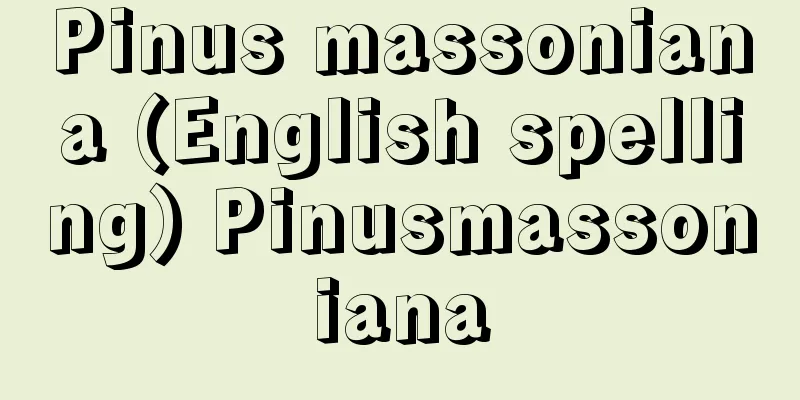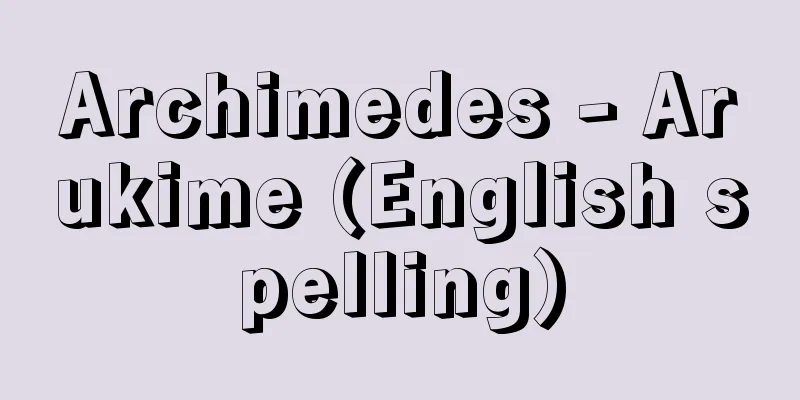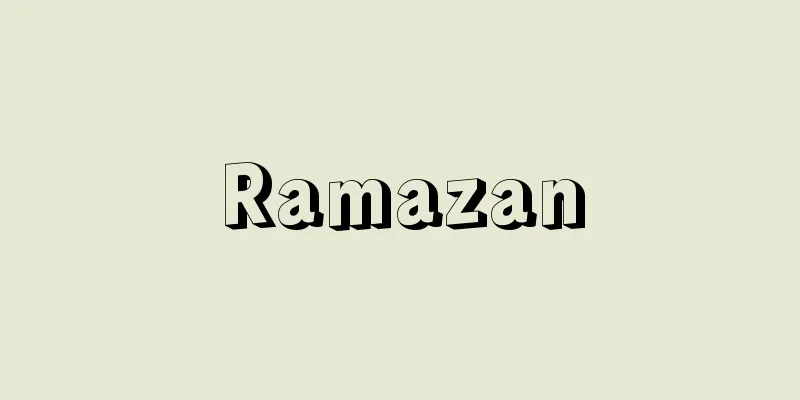Beetles - Kochu (English spelling)

|
A general term for animals that belong to the order Coleoptera (Insecta). This is the largest group of insects, and the largest number of species known, not just among insects, but among all animals. Currently, approximately 300,000 species have been recorded, and they are distributed all over the world except the polar regions, with approximately 8,000 species known from Japan. [Takehiko Nakane] formThe general characteristics of beetles are that the forewings are thickened and hardened, called the epithelium or elytra, and usually meet at the midline on the back to cover the back of the hind body, with the membranous hindwings tucked underneath; the mouthparts are usually suitable for biting, the mandibles are generally well developed, the prothorax is large and not attached to the hind body, allowing it to move; and the mesothorax is small. However, there is a great deal of variation in shape, with some exceptions in which the forewings have degenerated into small pieces. Overall shapes range from nearly circular or spherical to elongated rod-like, plate-like, gourd-shaped, and even some with projections and spines. Most are black or yellowish brown to brown in color, but there are also many beautiful metallic colors, and some species are red, yellow, green, and other varieties, with patterns and spots made of hair. [Takehiko Nakane] occurrenceThe eggs can be spherical, but are often oval to oblong or spindle-shaped, and some are curved like jelly beans. Diving beetles have elongated eggs that can reach 1 cm in length. A single female can lay anywhere from 2-3 eggs to several thousand. They often lay eggs on plants or near food that the larvae eat, but they can also lay them underground or inside plants. Some species, such as the Japanese scarab beetle and the burying beetle, bury eggs in dung balls or chunks of flesh buried underground and guard them, some leaf beetles cover their eggs with dung or secretions, and some water beetles create egg sacs by spinning threads. The larvae are long-horned or maggot-shaped, but some species, such as weevils, have degenerated legs, and some, such as the giant leaf beetle and ground beetle, undergo hypermetamorphosis, changing their body shape every time they molt. The pupa is usually naked, with no joints in the mandibles, and the wings and legs separate from the body. Many of them create a pupal chamber inside a plant or underground, but some, like weevils, spin cocoons, and some, like ladybugs, pupate inside the skin of their larvae. The emerged adult, like stag beetles, can remain in the pupal chamber for several months. [Takehiko Nakane] EcologyMost beetles, with a few exceptions, lead inconspicuous lives, but they live in a variety of places and ways. Some live on the ground, under stones or fallen trees in the mountains or fields, in fallen leaves or humus, while others live at low tide on the coast, in caves, or inside ant or termite nests. Some eat fallen leaves and humus, some prey on other small animals, and some gather on animal corpses and feces. Some live on plants, such as leaf beetles and weevils, and feed on the leaves, stems, wood, and roots of plants, while others gather on flowers and sap. Many are considered pests in agriculture, forestry, and gardening. Many are also known to live under the bark or in the wood of dead or rotting trees, and a number of species are found on various types of mushrooms. Furthermore, instead of eating natural substances as described above, beetles have shifted to eating things harvested and processed by humans, damaging stored grains, dried bonito flakes, dried fish and other foods, woolen fabrics, herbal medicines, furniture, building materials and specimens, and some even make holes in rubber and lead pipes. Other beetles that live in water include diving beetles, water beetles and water carnivores, and there are both carnivorous and herbivorous species, although there are a few that live in saltwater. Parasitic beetles include the Platypsyllus genus, which attaches to beavers, the giant flower beetle, whose larvae attach to wasps, and the bean tiger beetle, whose larvae feed on grasshopper eggs. [Takehiko Nakane] ClassificationBeetles are broadly divided into four suborders: (1) Carnivora, (2) Archaeophaga, (3) Myxophaga, and (4) Polyphaga. Suborders (2) and (3) contain only a few species, while most species belong to suborders (1) and (4). (1) Carnivora: The basal segment of the hind legs is fused to the posterior thorax, the first abdominal segment is divided in half in the middle, the abdominal segment usually has six segments, the first to third segments are fused. The dorsal plate of the prothorax bends downward from the lateral edge, there is a meeting line between the prothorax and the hind wings usually have a rectangular chamber. The tarsus of the legs has five segments. There are two groups, terrestrial and aquatic. The former includes mainly terrestrial families such as tiger beetles, stag beetles, hairless ground beetles, ground beetles, and dung beetles. The latter includes families such as diving beetles, small water beetles, water beetles, and water beetles, and both are mostly carnivorous. Among the families, the family Carabidae includes the greatest number of species, and most of the species of the suborder belong to this group. (2) Archaeomorpha: They are close to the Carnivora, but the basal segments of the hind legs are not fused to the metathorax, and they do not divide the first abdominal plate. Some have a line where the dorsal plate and lateral plate meet on both sides of the underside of the prothorax, and the tips of the hind wings are curled in a spiral when at rest. They include two families, with long and slender bodies, the Longhorn family lives in rotting wood, has granules on the body surface, the upper wings have a lattice-like structure, and there are many fossil species. The Longhorn family includes one small species that lives on wood and has complex reproduction including larval reproduction and hypermetamorphosis. (3) Myxophaga: A group of tiny beetles with meeting lines on both sides of the underside of the pronotum, rectangular chambers on the hind wings, and swollen, bulbous tips of the antennae. This includes four families, such as the brown spotted beetle and the deutzia beetle. (4) Polyphaga: This suborder contains a wide variety of species and is divided into six groups, which are further divided into major families (superfamilies). Group 1, the Staphylinidae type group, consists of three families: Hydrophilidae (Braunculidae, Hydrophilidae, Hydrophilidae, etc.), Psathyridae (three families: Psathyridae, Psathyridae, and Psathyridae), and Staphylinidae (Psathyridae, Psathyridae, Bryophytes, Silphidae, Staphylinidae, Pseudopygiidae, etc.). Of these, the Staphylinidae family has the greatest number of species, and along with the Psathyridae family, they gather on animal dung, carcasses, or mushrooms, and are found under tree bark, on flowers, leaves, and under stones, and some live in fallen leaves and humus soil along with Psathyridae, Bryophytes, and Pseudopygiidae. Hydrophils are mainly aquatic, but some gather on dung and filth on land, and some live on the coast. The second group, the Scarabaeidae family, includes the Stag Beetles, Black Gem Beetles, Scarab Beetles, Knob Scarab Beetles, Geodude Beetles, and other families, and mainly feed on plant matter, but some of the Scarabaeidae family and the two families mentioned below tend to gather on animal feces and corpses. The Long-stem Aphididae family (such as the Ctenoceridae family) is also included here. The third group, the round-leaf moth type group, contains only the main family Round-leaf moth (three families: the round-leaf moth, the round-leaf moth, and the burdock moth). The fourth group, the click beetle type group, includes various species such as the family Polytrichum commune (Pontedidae), the family Dorcus commune (flat-headed dorcus, long-flowered beetles, double-headed dorcus, small dorcus, long-headed dorcus, Ellipsidae, etc.), the family Long-flowered beetles (Narrow-headed beetles, etc.), the family Buprestidae (Buprestidae), the family Elateridae (click beetles, click beetles, Aleuritesidae), and the family Fireflies (narrow-headed fireflies, fireflies, red fireflies, Canthariidae, etc.). Some species, such as Dorcus communes, are found in water or wetlands during their young stage, while others, such as jewel beetles and click beetles, have larvae that are found inside plants and dead trees, and some, such as fireflies, have weak bodies but many are carnivorous. The fifth group, the long-breed moth type group, consists of the main family Dermestidae (such as false windbreakers, small spiny beetles, and Dermestidae) and the main family Bostricidae (such as sand beetles, large ear beetles, long-breed moths, and flat-headed beetles), and includes pests that damage food, wood, and furniture. The sixth group, the flathead beetle type group, is the most diverse and contains the greatest number of species, and includes the coccinellid family (castor beetles, cuckoo beetles, and the family Heteroptera), the common grass beetle family (Common grass beetles), the flathead beetle family (narrow grass beetles, brown grass beetles, flathead beetles, narrow grass beetles, leaf beetles, yellow grass beetles, false leaf beetles, false rice grass beetles, giant mushroom beetles, shriveled flower beetles, water beetles, ladybird beetles, ladybird beetles, water beetle false beetles, and shriveled flower beetles), and the common grass beetle group (small grass beetles, small grass beetles, narrow grass beetles, meal beetles, leaf beetles, cut beetles, mushroom beetles, cut beetles, rove beetles, These include the following families: heterophylla (families including stag beetles, small leaf beetles, yellow leaf beetles, false stag beetles, red blade beetles, long-mouth beetles, flower beetles, flower beetles, giant flower beetles, false long-horn beetles, ground beetles, false ant beetles, false crib beetles, and long-neck beetles), the main families of leaf beetles (long-horn beetles, beetles, Chrysomelidae), and the main families of curculionidae (long-horn beetles, leaf beetles, honeysuckle weevils, narrow-mouth weevils, weevils, bark beetles, and long-neck beetles), with the exception of the first main family, many of them feed mainly on plant matter and grow on rotting wood and mushrooms, and the last two main families contain many pests that are used in agriculture and forestry, and there are an extremely large number of species, including weevils, leaf beetles, and long-horn beetles. [Takehiko Nakane] "Nakane Takehiko et al., "Colored Insect Encyclopedia II: Beetles" (1963, Hokuryukan)" ▽ "Hayashi Nagayasu, "Observation and Rearing of Beetles" (1973, New Science Publishing)" ▽ "Nakane Takehiko, Supervisor, "Gakken Biological Encyclopedia: Insects II: Beetles" (1983, Gakken)" Source: Shogakukan Encyclopedia Nipponica About Encyclopedia Nipponica Information | Legend |
|
昆虫綱甲虫目(鞘翅類(しょうしるい))Coleopteraに属する動物の総称。この類は昆虫類のみならず動物全体のなかでももっとも多数の種類が知られている大群である。現在およそ30万種が記録されており、極地を除く世界各地に分布し、日本からも約8000種が知られる。 [中根猛彦] 形態甲虫の一般的な特徴は、前ばねが肥厚し硬くなって上ばねまたは翅鞘(ししょう)(さやばね)とよばれ、普通、左右が背面の正中線であわさって後体部背面を覆い、膜質の後ろばねがその下に収められること、口器が普通かむのに適し、大あごの発達が一般によいこと、前胸が大きくて後体部に密着せず、動かせることと、中胸が小さいことなどがあげられる。しかし、形はきわめて変化に富み、なかには前ばねが退化して小片になったり、例外的なものもある。全形は、ほぼ円形や球形のものから、細長い棒状や板状、ひょうたん形、さらに突起や棘(とげ)のあるものなどがある。色は黒色、または黄褐色から褐色が多いが、美しい金属色のものも少なくなく、赤、黄、緑などの種類、紋様のあるもの、毛で斑紋(はんもん)ができているものもある。 [中根猛彦] 発生卵は球形のこともあるが、卵形から長楕円(ちょうだえん)形か紡錘形が多く、ゼリービーンズ状に曲がったものもある。ゲンゴロウの卵は細長く1センチメートルに達する。雌1匹の産卵数は2、3個から数千のものまである。産卵場所は幼虫の食物になる植物上や餌(えさ)のそばが多いが、地中や植物内に産み込むこともある。また、ダイコクコガネやモンシデムシのように地中に糞球(ふんきゅう)や肉塊を埋めて産卵し、番をするもの、一部のハムシのように卵を糞や分泌物で覆うもの、ガムシのように糸を出して卵嚢(らんのう)をつくるものなどがある。幼虫はナガコムシ形かウジムシ形であるが、ゾウムシなど脚(あし)の退化したもの、脱皮するごとに体形の変わるオオハナノミ、ツチハンミョウなど過変態をするものもある。蛹(さなぎ)は普通、裸蛹(らよう)で、大あごに関節がなく、はねや脚が体から離れており、植物中、地中などに蛹室をつくるものが多く、ある種のゾウムシのように繭を紡ぐものや、テントウムシのように幼虫の皮の中で蛹になるものもある。羽化した成虫は、クワガタムシなど蛹室に数か月もとどまることがある。 [中根猛彦] 生態甲虫は一部を除いて目だたない生活をしているものが多いが、すむ場所やすみ方もさまざまである。地面にいるものも、野山の石や倒木の下、落ち葉や腐植土の中にいるものから、海岸の干潮線、洞穴内、アリやシロアリの巣内にすむものなどあって、落ち葉や腐植質を食べるもの、ほかの小動物を捕食するもの、動物の死体、糞に集まるものなどがある。植物上で生活するものにも、ハムシ、ゾウムシなど草木の葉、茎、材、根を食べるもの、花や樹液に集まるものがあり、農林業や園芸の害虫とされるものも多い。また、枯れ木や朽ち木の皮下や材の中にすむものも多数知られており、諸種のキノコにみられる種数も少なくない。さらに、以上の自然物を食する生活から、人間の収穫・加工したものに移り、貯蔵穀類、かつお節、干し魚などの食品、毛織物、生薬(しょうやく)、家具、家材、標本などを害するものも甲虫が多く、ゴム管や鉛管に孔(あな)をあけるものさえある。このほか水中の生活をするものにゲンゴロウ、ミズスマシ、ガムシなどがあり、食性も肉食と草食とあり、少数であるが海水にいる種類もある。寄生性のものではビーバーにつくプラティプシラス属Platypsyllus、幼虫がハチにつくオオハナノミなどがあり、幼虫がバッタの卵を食べるマメハンミョウもある。 [中根猛彦] 分類甲虫は大別して次の4亜目、つまり(1)食肉亜目、(2)始原亜目、(3)粘食亜目、(4)多食亜目に分けられるが、(2)(3)の亜目は少数の種類を含み、ほとんどの種類は(1)(4)の亜目に属する。 (1)食肉亜目 後肢(こうし)の基節が後胸板と合着し、第1腹節を中央で二分し、腹節は普通6節あり、第1~3節は合着している。前胸の背板は側縁から下面へ折れ曲がり、前胸側板との間に会合線があり、後ろばねは普通長方形室をもつ。脚の跗節(ふせつ)は5節。陸生と水生の2群があり、前者にはハンミョウ、セスジムシ、ヒゲブトオサムシ、オサムシ、ゴミムシなどおもに地表性の科が属する。後者にはゲンゴロウ、コツブゲンゴロウ、ミズスマシ、コガシラミズムシなどの科が含まれ、いずれも肉食の種類がほとんどを占める。科のなかでは、ゴミムシ科がきわめて多くの種を含み、亜目の大部分の種がここに属する。 (2)始原亜目 食肉亜目に近いが、後肢の基節は後胸板と合着せず、また第1腹板を二分しない。前胸下面の両側にある背板と側板の会合線は、あるものとないものがあり、後ろばねは静止するときに先端を螺旋(らせん)状に巻く。2科を含み、体形は細長く、ナガヒラタムシ科は朽ち木にすみ、体表に顆粒(かりゅう)があり、上ばねは格子状の構造をもち、化石種が多い。チビナガヒラタムシ科は材木につき、幼生生殖や過変態を含む複雑な繁殖をする小さな1種を含む。 (3)粘食亜目 微小な甲虫の一群、前胸下面両側の会合線をもち、後ろばねには長方形室があるが、触角の先端は膨れて球桿(きゅうかん)をつくる。ケシマルムシ、デオミズムシなど4科が含まれる。 (4)多食亜目 ここには変化に富んだ多数の種類が含まれており、6群に大別され、さらにその下に主科(上科)が区分されている。 第1群ハネカクシ型群は、ガムシ主科(ダルマガムシ、ホソガムシ、ガムシ、マルドロムシ科など)、エンマムシ主科(エンマムシダマシ、エンマムシモドキ、エンマムシの3科)、ハネカクシ主科(ムクゲキノコムシ、タマキノコムシ、コケムシ、シデムシ、デオキノコムシ、ハネカクシ、アリヅカムシ科など)の3主科があり、なかではハネカクシ科がもっとも種数が多く、エンマムシ科とともに動物の糞や死体あるいはキノコに集まり、樹皮下にもおり、また花上、葉上、石下などに発見され、ムクゲキノコムシ、コケムシ、アリヅカムシ科とともに落ち葉や腐植土の中にすむものもある。ガムシ類はおもに水生であるが、一部は陸上で糞や汚物に集まり、海浜生のものもある。 第2群コガネムシ型群の、コガネムシ主科にはクワガタムシ、クロツヤムシ、コガネムシ、コブスジコガネ、センチコガネなどの諸科が含まれ、おもに植物質を食べるが、コガネムシ科の一部と後記の2科は動物の糞や死体に集まるものが多い。ナガフナガタムシ主科(クシヒゲムシ科など)もここに含まれる。 第3群マルハナノミ型群には、マルハナノミ主科(ハナノミダマシ、マルハナノミ、タマキノコムシダマシの3科)だけである。 第4群コメツキ型群には、マルトゲムシ主科(マルトゲムシ科)、ドロムシ主科(ヒラタドロムシ、ナガハナノミ、ダエンマルトゲムシ、チビドロムシ、ナガドロムシ、ヒメドロムシ科など)、ナガハナノミダマシ主科(ホソクシヒゲムシ科など)、タマムシ主科(タマムシ科)、コメツキムシ主科(コメツキムシ、コメツキダマシ、ヒゲブトコメツキ科)、ホタル主科(ホソホタルモドキ、ホタル、ベニボタル、ジョウカイボン科など)と、いろいろな類がここに属し、ドロムシ類のように幼期に水中や湿地に多いもの、タマムシ、コメツキムシ類のように幼虫が植物内、枯れ木に多いもの、ホタル類のように体は軟弱であるが肉食性の種が多いものなどがある。 第5群ナガシンクイ型群は、カツオブシムシ主科(マキムシモドキ、ヒメトゲムシ、カツオブシムシ科など)と、ナガシンクイ主科(シバンムシ、ヒョウホンムシ、ナガシンクイ、ヒラタキクイムシ科)からなり、食品や木材、家具を食害する害虫が含まれている。 第6群ヒラタムシ型群は、もっともさまざまで多数の類が含まれ、カッコウムシ主科(コクヌスト、カッコウムシ、ジョウカイモドキ科など)、ツツシンクイ主科(ツツシンクイ科)、ヒラタムシ主科(ケシキスイ、ネスイムシ、ツツヒラタムシ、ヒラタムシ、ホソヒラタムシ、キスイムシ、ムクゲキスイ、キスイモドキ、コメツキモドキ、オオキノコムシ、ヒメハナムシ、ミジンムシ、テントウダマシ、テントウムシ、ミジンムシダマシ、ヒメマキムシなどの球角群と、ツツキノコムシ、コキノコムシ、ホソカタムシ、ゴミムシダマシ、ハムシダマシ、クチキムシ、キノコムシダマシ、クチキムシダマシ、ハネカクシダマシ、チビキカワムシ、キカワムシ、クワガタモドキ、アカハネムシ、ナガクチキムシ、ハナノミダマシ、ハナノミ、オオハナノミ、カミキリモドキ、ツチハンミョウ、アリモドキ、ニセクビボソムシ、クビナガムシなどの異節群の諸科)、ハムシ主科(カミキリムシ、マメゾウムシ、ハムシ科)、ゾウムシ主科(ヒゲナガゾウムシ、オトシブミ、ミツギリゾウムシ、ホソクチゾウムシ、ゾウムシ、キクイムシ、ナガキクイムシ科など)が属し、最初の主科を除き、主として植物質を食し、朽ち木やキノコで育つものも多く、最後の2主科は農林業上の害虫が多く、種数もゾウムシ、ハムシ、カミキリムシなどきわめて多い。 [中根猛彦] 『中根猛彦他著『原色昆虫大図鑑Ⅱ 甲虫篇』(1963・北隆館)』▽『林長閑著『甲虫の観察と飼育』(1973・ニュー・サイエンス社)』▽『中根猛彦監修『学研生物図鑑 昆虫Ⅱ 甲虫』(1983・学習研究社)』 出典 小学館 日本大百科全書(ニッポニカ)日本大百科全書(ニッポニカ)について 情報 | 凡例 |
Recommend
Asada - Asada (English spelling) hop-hornbeam
A deciduous tall tree of the Betulaceae family (A...
Rickmann, J.
...While persistent hypochondria, obsessions or f...
Rhyme - Kan'in
〘Noun〙 A method of rhyming in Chinese poetry. In a...
Business cycle - English
In a capitalist economy, booms, when economic act...
Krupp Polysius AG
...The company is a holding company, with about 7...
heavy duty detergent
...Its uses include the textile, paper and pulp i...
Stent - Stent
It is a lumen-retaining mold (a straw-like structu...
Ayamodoshi - Ayamodoshi
... Aya refers to a small movement that is unrela...
Virbius (English spelling)
An ancient Italian god. He was worshipped together...
advocacy ad (English spelling) advocacyad
...Since the late 1970s, in addition to governmen...
Amakusa Islands
An archipelago located in the southwest of Kumamo...
Genjitsu (English spelling) Yan Shi; Yen Shih
[Birth] Taisei 22 (1182) [Died] King Taejong 12 (1...
Allosteric effect
The phenomenon in which a graph showing the relat...
Saldanha, João Carlos de Saldanh a Oliveira e Daun, Duque de
Born: November 17, 1790, Ajinaga Died November 21,...
Mauritia mauritiana (English spelling)
...It is found in the tropical Pacific Ocean and ...









